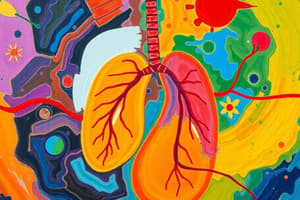Podcast
Questions and Answers
What is the main purpose of paying off the oxygen debt after anaerobic respiration?
What is the main purpose of paying off the oxygen debt after anaerobic respiration?
- To reduce water production
- To increase carbon dioxide levels
- To eliminate lactic acid (correct)
- To produce more glucose
Which of the following statements is true regarding anaerobic respiration in yeast?
Which of the following statements is true regarding anaerobic respiration in yeast?
- It occurs only in plants.
- It produces glucose and water.
- Anaerobic respiration requires oxygen.
- It produces alcohol and carbon dioxide. (correct)
Which product is a result of anaerobic respiration in animal cells?
Which product is a result of anaerobic respiration in animal cells?
- Ethanol
- Lactic acid (correct)
- Oxygen
- Glucose
What do bakers use the carbon dioxide produced from anaerobic respiration for?
What do bakers use the carbon dioxide produced from anaerobic respiration for?
In what primary way does anaerobic respiration differ from aerobic respiration?
In what primary way does anaerobic respiration differ from aerobic respiration?
Which of the following is NOT a characteristic of anaerobic respiration?
Which of the following is NOT a characteristic of anaerobic respiration?
Which of the following is a final product of fermentation in yeast?
Which of the following is a final product of fermentation in yeast?
During anaerobic respiration, yeast can convert glucose into which of the following?
During anaerobic respiration, yeast can convert glucose into which of the following?
Flashcards are hidden until you start studying
Study Notes
Anaerobic Respiration in Animals
- Anaerobic respiration occurs in animals when oxygen is limited. This happens during intense exercise when the body cannot supply enough oxygen to the muscles.
- During anaerobic respiration, glucose is broken down into lactic acid, which releases a small amount of energy.
- Oxygen debt is the amount of oxygen needed to get rid of lactic acid after exercise.
- The lactic acid is converted back to glucose using oxygen.
- Lactic acid is a waste product of anaerobic respiration.
Anaerobic Respiration in Microorganisms and Plants
- Some plants and yeast cells can respire anaerobically, a process called fermentation.
- Fermentation produces carbon dioxide and alcohol (ethanol) as by-products.
- Fermentation is used in the brewing industry to make beer and wine.
- Bacteria also carry out anaerobic respiration, releasing energy from glucose.
Aerobic vs. Anaerobic Respiration Comparison
- Aerobic respiration requires oxygen.
- Anaerobic respiration does not require oxygen.
- Both aerobic and anaerobic respiration require glucose.
- Aerobic respiration produces carbon dioxide and water.
- Anaerobic respiration produces lactic acid in animals and alcohol (ethanol) and carbon dioxide in some plants and microorganisms.
Anaerobic Respiration in Sports
- Anaerobic respiration is important in sports, especially during short, intense bursts of activity.
- Examples of sports that rely on anaerobic respiration include weightlifting and sprinting.
- This type of respiration allows athletes to produce energy quickly, even when oxygen supply is limited.
Studying That Suits You
Use AI to generate personalized quizzes and flashcards to suit your learning preferences.




